The automotive market is a constantly evolving landscape, and two of the most compelling entrants in the compact SUV segment are the Mazda CX-5 and the Toyota Corolla Cross. These vehicles offer a blend of style, performance, and practicality, making them attractive choices for contemporary drivers. In this comparison, we delve into their technical specifications, innovations, and key features that set them apart.
Mazda CX-5 vs Toyota Corolla Cross – Differences & prices compared
Everyday use, family trips or long-distance drives – here’s where the differences show.
Discover whether Mazda CX-5 or Toyota Corolla Cross fits your lifestyle better.
Design and Dimensions
The Mazda CX-5 boasts a sleek and athletic design with a length of 4575 mm, a width of 1845 mm, and a height of 1680 mm. Its bold front grille and expressive body lines give it a premium look, drawing attention on the streets.
In contrast, the Toyota Corolla Cross is slightly smaller, measuring 4460 mm in length, 1825 mm in width, and 1620 mm in height. Its design reflects Toyota's family styling cues, presenting a more understated, yet modern appearance. Both vehicles feature five doors and seating for five, catering well to families and commuters alike.
Powertrains and Performance
The powertrains of the Mazda CX-5 are varied, offering petrol MHEV and diesel engine options that deliver between 150 to 194 horsepower. The drivetrain can be either front-wheel or all-wheel drive, with a choice of manual or automatic transmission. Notable acceleration figures vary, with the CX-5 achieving 0-100 km/h in as little as 9.2 seconds, underlining its agility and performance.
On the other hand, the Toyota Corolla Cross comes with a full hybrid engine, producing up to 197 hp. It features an automatic transmission with a CVT, which enables seamless acceleration and efficiency. The Corolla Cross excels in this area, achieving 0-100 km/h in a swift 7.6 seconds for the top hybrid variant, showcasing its sporty demeanor.
Fuel Efficiency and Environmental Impact
Fuel consumption is a crucial aspect for buyers today, and the Mazda CX-5 demonstrates commendable numbers, ranging from 5.6 to 7.6 L/100 km depending on the configuration. Its CO2 emissions are rated between 146 g/km and 173 g/km, offering a relatively efficient profile in the SUV segment.
The Corolla Cross stands out in fuel efficiency with consumption figures as low as 5.1 L/100 km, and its CO2 emissions being notably lower, ranging from 114 g/km to 121 g/km. With its hybrid technology, the Corolla Cross appeals to eco-conscious consumers who prioritize sustainability without compromising performance.
Interior and Technology
Inside, the Mazda CX-5 is known for its upscale materials and elegant design. The cabin offers ample space, with a trunk capacity of 522 liters, making it practical for daily use and long journeys. Technology features include a user-friendly infotainment system and advanced driver assistance systems that enhance safety and comfort.
Similarly, the Toyota Corolla Cross provides a comfortable cabin with a trunk capacity ranging from 414 to 425 liters. Its technology suite includes a comprehensive infotainment system, compatible with Apple CarPlay and Android Auto, as well as a selection of safety features that align with Toyota’s safety-first approach.
Conclusion
In summary, both the Mazda CX-5 and Toyota Corolla Cross present themselves as solid choices in the compact SUV segment. The CX-5 leans towards a more powerful performance and a luxurious feel, while the Corolla Cross prioritizes fuel efficiency and eco-friendliness. Depending on a driver’s priorities—be it power, hybrid technology, interior luxury, or fuel economy—each vehicle provides unique advantages that cater to a diverse range of consumer preferences.
Ultimately, the choice between the Mazda CX-5 and the Toyota Corolla Cross will depend on individual driving needs and lifestyle—making both vehicles a worthy consideration in today’s competitive automotive landscape.
Here’s where it gets real: The technical differences in detail
Costs and Efficiency:
Price and efficiency are key factors when choosing a car – and this is often where the real differences emerge.
Mazda CX-5 has a minimal advantage in terms of price – it starts at 30000 £, while the Toyota Corolla Cross costs 31700 £. That’s a price difference of around 1705 £.
Fuel consumption also shows a difference: Toyota Corolla Cross manages with 4.90 L and is therefore clearly more efficient than the Mazda CX-5 with 7 L. The difference is about 2.10 L per 100 km.
Engine and Performance:
Power, torque and acceleration are the classic benchmarks for car enthusiasts – and here, some clear differences start to show.
When it comes to engine power, the Toyota Corolla Cross has a clearly perceptible edge – offering 180 HP compared to 141 HP. That’s roughly 39 HP more horsepower.
In acceleration from 0 to 100 km/h, the Toyota Corolla Cross is clearly perceptible quicker – completing the sprint in 7.60 s, while the Mazda CX-5 takes 10.50 s. That’s about 2.90 s faster.
In terms of top speed, the Mazda CX-5 performs minimal better – reaching 195 km/h, while the Toyota Corolla Cross tops out at 180 km/h. The difference is around 15 km/h.
Space and Everyday Use:
Cabin size, boot volume and payload all play a role in everyday practicality. Here, comfort and flexibility make the difference.
Both vehicles offer seating for 5 people.
In curb weight, Toyota Corolla Cross is somewhat lighter – 1380 kg compared to 1629 kg. The difference is around 249 kg.
In terms of boot space, the Mazda CX-5 offers clearly perceptible more room – 583 L compared to 425 L. That’s a difference of about 158 L.
In maximum load capacity, the Mazda CX-5 performs noticeable better – up to 2019 L, which is about 682 L more than the Toyota Corolla Cross.
Who wins the race?
The Toyota Corolla Cross proves to be outperforms in nearly all aspects and therefore becomes our DriveDuel Champion!
Toyota Corolla Cross is the better all-rounder in this comparison.
 @ Toyota Motor Corporation
@ Toyota Motor Corporation
Toyota Corolla Cross
Mazda CX-5
The Mazda CX-5 blends elegant, athletic styling with a surprisingly engaging driving character, turning routine trips into small, satisfying adventures. Inside it feels thoughtfully built and comfortable, offering sensible practicality and a premium feel that punches above its price.
details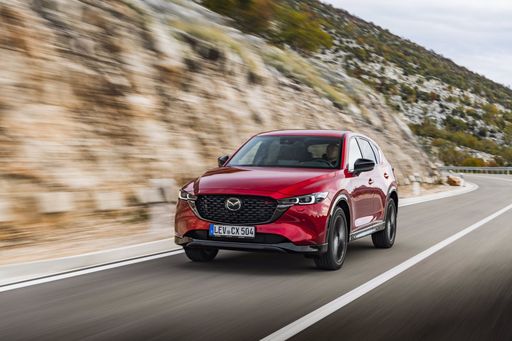 @ Mazda Motor Corporation
@ Mazda Motor Corporation
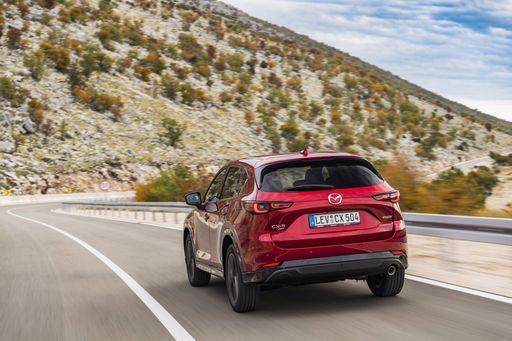 @ Mazda Motor Corporation
@ Mazda Motor Corporation
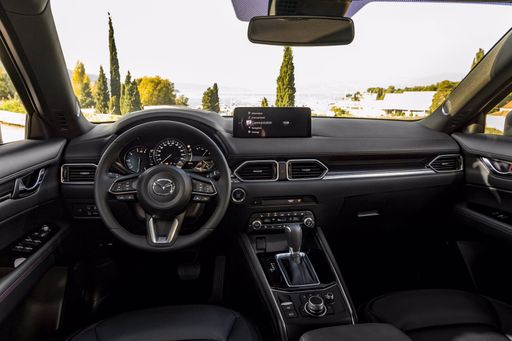 @ Mazda Motor Corporation
@ Mazda Motor Corporation
Toyota Corolla Cross
The Toyota Corolla Cross takes the familiar Corolla recipe, lifts it up and dresses it in SUV clothes — sensible, comfortable and blessedly unflashy. It won’t thrill the enthusiast, but its easy manners, clever packaging and dependable feel make it an ideal everyday car for shoppers who prefer sense over sass.
details @ Toyota Motor Corporation
@ Toyota Motor Corporation
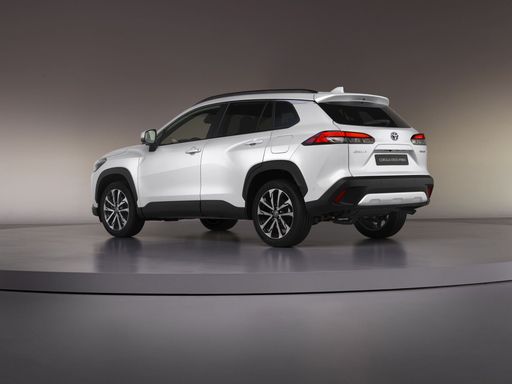 @ Toyota Motor Corporation
@ Toyota Motor Corporation
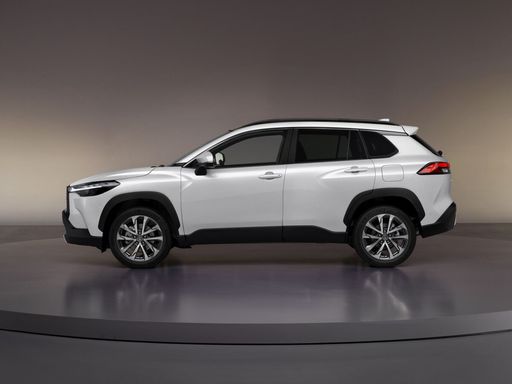 @ Toyota Motor Corporation
@ Toyota Motor Corporation
 @ Toyota Motor Corporation
@ Toyota Motor Corporation
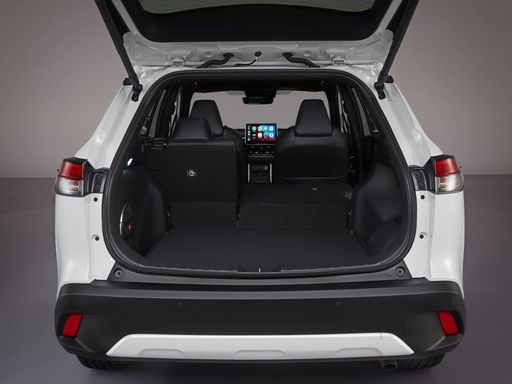 @ Toyota Motor Corporation
@ Toyota Motor Corporation
 @ Mazda Motor Corporation
@ Mazda Motor Corporation
|
 @ Toyota Motor Corporation
@ Toyota Motor Corporation
|
|
|
|
Costs and Consumption |
|
|---|---|
|
Price
30000 - 39500 £
|
Price
31700 - 41900 £
|
|
Consumption L/100km
7 - 7.4 L
|
Consumption L/100km
4.9 - 5.3 L
|
|
Consumption kWh/100km
-
|
Consumption kWh/100km
-
|
|
Electric Range
-
|
Electric Range
-
|
|
Battery Capacity
-
|
Battery Capacity
-
|
|
co2
157 - 168 g/km
|
co2
112 - 120 g/km
|
|
Fuel tank capacity
56 - 58 L
|
Fuel tank capacity
36 - 43 L
|
Dimensions and Body |
|
|---|---|
|
Body Type
SUV
|
Body Type
SUV
|
|
Seats
5
|
Seats
5
|
|
Doors
5
|
Doors
5
|
|
Curb weight
1629 - 1671 kg
|
Curb weight
1380 - 1500 kg
|
|
Trunk capacity
583 L
|
Trunk capacity
414 - 425 L
|
|
Length
4690 mm
|
Length
4460 mm
|
|
Width
1860 mm
|
Width
1825 mm
|
|
Height
1695 mm
|
Height
1620 mm
|
|
Max trunk capacity
2019 L
|
Max trunk capacity
1333 - 1337 L
|
|
Payload
-
|
Payload
515 - 560 kg
|
Engine and Performance |
|
|---|---|
|
Engine Type
Petrol MHEV
|
Engine Type
Full Hybrid
|
|
Transmission
Automatic
|
Transmission
Automatic
|
|
Transmission Detail
Automatic Gearbox
|
Transmission Detail
CVT
|
|
Drive Type
Front-Wheel Drive, All-Wheel Drive
|
Drive Type
Front-Wheel Drive, All-Wheel Drive
|
|
Power HP
141 HP
|
Power HP
140 - 180 HP
|
|
Acceleration 0-100km/h
10.5 - 10.9 s
|
Acceleration 0-100km/h
7.6 - 10 s
|
|
Max Speed
195 km/h
|
Max Speed
170 - 180 km/h
|
|
Torque
238 Nm
|
Torque
-
|
|
Number of Cylinders
4
|
Number of Cylinders
4
|
|
Power kW
104 kW
|
Power kW
103 - 132 kW
|
|
Engine capacity
2488 cm3
|
Engine capacity
1798 - 1987 cm3
|
General |
|
|---|---|
|
Model Year
2025
|
Model Year
2025
|
|
CO2 Efficiency Class
F
|
CO2 Efficiency Class
C, D
|
|
Brand
Mazda
|
Brand
Toyota
|
What drivetrain options does the Mazda CX-5 have?
The Mazda CX-5 is offered with Front-Wheel Drive or All-Wheel Drive.
The prices and data displayed are estimates based on German list prices and may vary by country. This information is not legally binding.
